Football as a sport has no shortage of feel-good stories when it comes to underdogs overperforming expectations (Leicester City winning the Premier League in the 2015/16 season) or in terms of players developing in the non-league or lower league and going on to have extremely successful careers (Jamie Vardy was a key part of that Leicester City season). While in previous years, the 1980’s and 1990’s for example we would see players playing non-league football before getting picked up by top-flight clubs. These players would typically be working second jobs, and back then the financial incentives for making the step up in league quality were not what it is now. When Stuart Pearce made the move from non-league to Nottingham Forest, for example, he continued to advertise his services as an electrician in the matchday program.
Fast forward to today and we still see a lot of players making the transition from non-league football to the football league in England, although the environment in the non-leagues has significantly changed. There are clubs now in the non-league, especially in the National League, that maintain professional status and there have been instances of players actually dropping down to clubs at that level because they are offering better wages. There will always be talent within football that can be described as ‘sleeping’ and players will be released from league clubs before going in to make an impact at the professional level later on in their career.
That is the case with the subject of this scout report as the 20-year-old Fleetwood Town midfielder Paddy Lane was released as a 15-year-old by Blackburn Rovers before dropping out of league football to play for the likes of Hyde United and Farsley Celtic before being signed by Fleetwood Town to join their side in League One. Fast forward to the end of the 2021/22 season and Lane has been called up to the senior international set-up by Northern Ireland and been named as the League One young player of the year by the EFL. Not bad for a player who had to work a series of part-time jobs to supplement his income as he played regular non-league football.
Recent weeks have seen Lane linked to transfers to the lines of West Ham United in the Premier League, and Stoke City in the Championship, and it feels like a matter of time before Lane is the next player to leave Fleetwood Town to move up the football pyramid.
This tactical analysis will be an analysis of Lane’s data across the 2021/22 season while looking at some of his key strengths as a player and where he fits into his side’s tactics.
Data Analysis
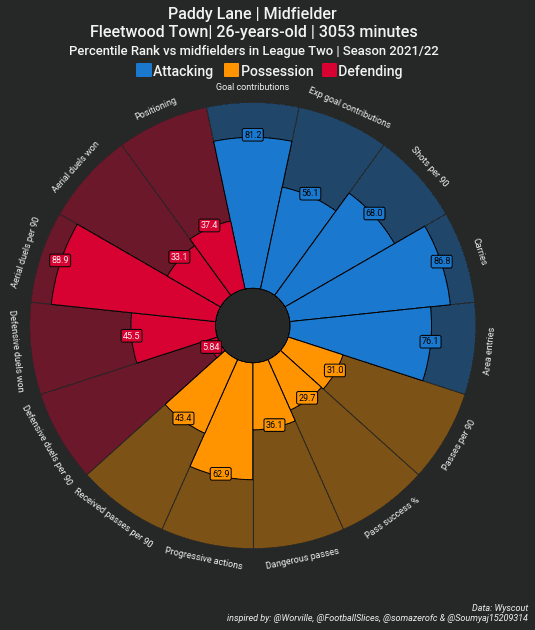
The first thing that we have to cover is that Lane played a number of different positions across the course of the season. He featured in the centre of the midfield, on either wing and as a wingback at various points and in some games, he even covered more than one position in a single game.
The pizza chart above is based on a comparison of all central midfielders in League One. We have used Wyscout data and converted the raw per 90 data into percentile rankings for each of the areas of the game shown in the pizza chart. We can quickly see that for a player who we are classifying largely as a central midfielder Lane does not have great output when it comes to passing and ball progression. This is partly because of his positional versatility as wingers and wingbacks do not see the same touches as midfielders in terms of creating volume but it is also because of his playing profile. Lane is a midfielder who is at his best in the attacking phase when the ball is travelling into the final third.
He is capable of receiving in the half-spaces and on the turn in areas where he can take the ball and either create a shooting angle for himself or find a passing option to release a teammate into space behind the defensive line.
Creating shooting opportunities
Paddy Lane is a player who thrives when he is able to receive and play in pockets of space around the final third. His movement off the ball is typically aggressive in terms of making movements to create separation from the opposition defenders and to find pockets of space in which he can receive the ball. When the ball is in the middle third he does, from time to time, drop in front of the midfield block of the opposition in order to receive the ball and look to progress the play but his preference is to be able to take possession of the ball in the half-spaces.
From these areas in advanced positions, Lane is a threat to either get turned and attack the inside or the outside of the defender. He is predominantly left-footed but he has the ability to use his right as well, something that is often lacking in modern players. When he is moving in possession of the ball, Lane generates power and has shown himself to be a dangerous striker of the ball from distance.
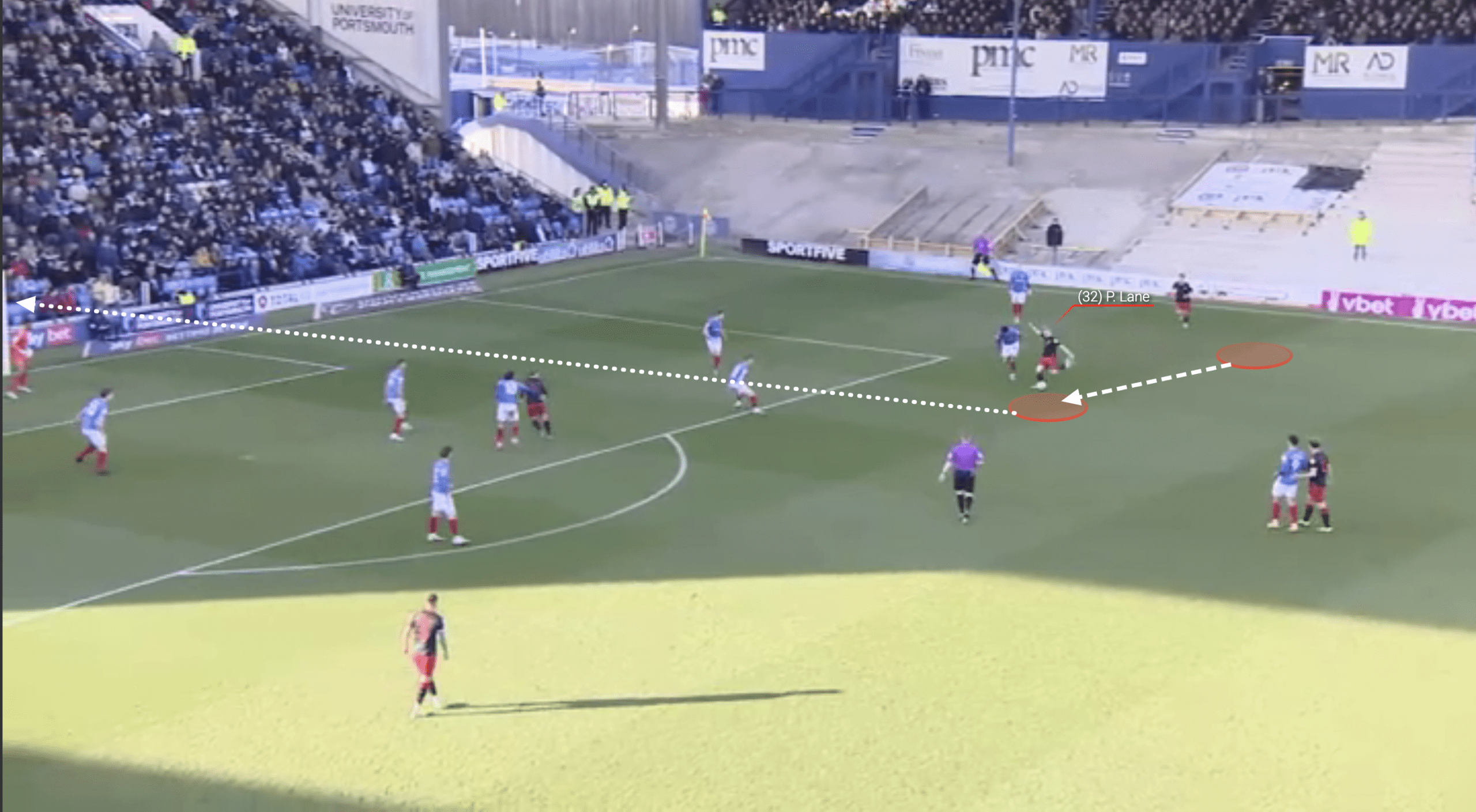
In this example, we see that Lane picked up the ball out in the right half-space with a teammate in position to support him on the outside. When Lane took possession he had an opposition defender who was positioned tight against him but he made the choice to drop his shoulder and drive inside.
In making this movement Lane has left the defender behind and created separation. In most cases, we would expect the player in possession in this area to continue to carry the ball across the field or to look for a runner that he could slip the ball into. Instead, we see Lane take a shot that generates real power as he strikes the ball past the opposition goalkeeper from range.
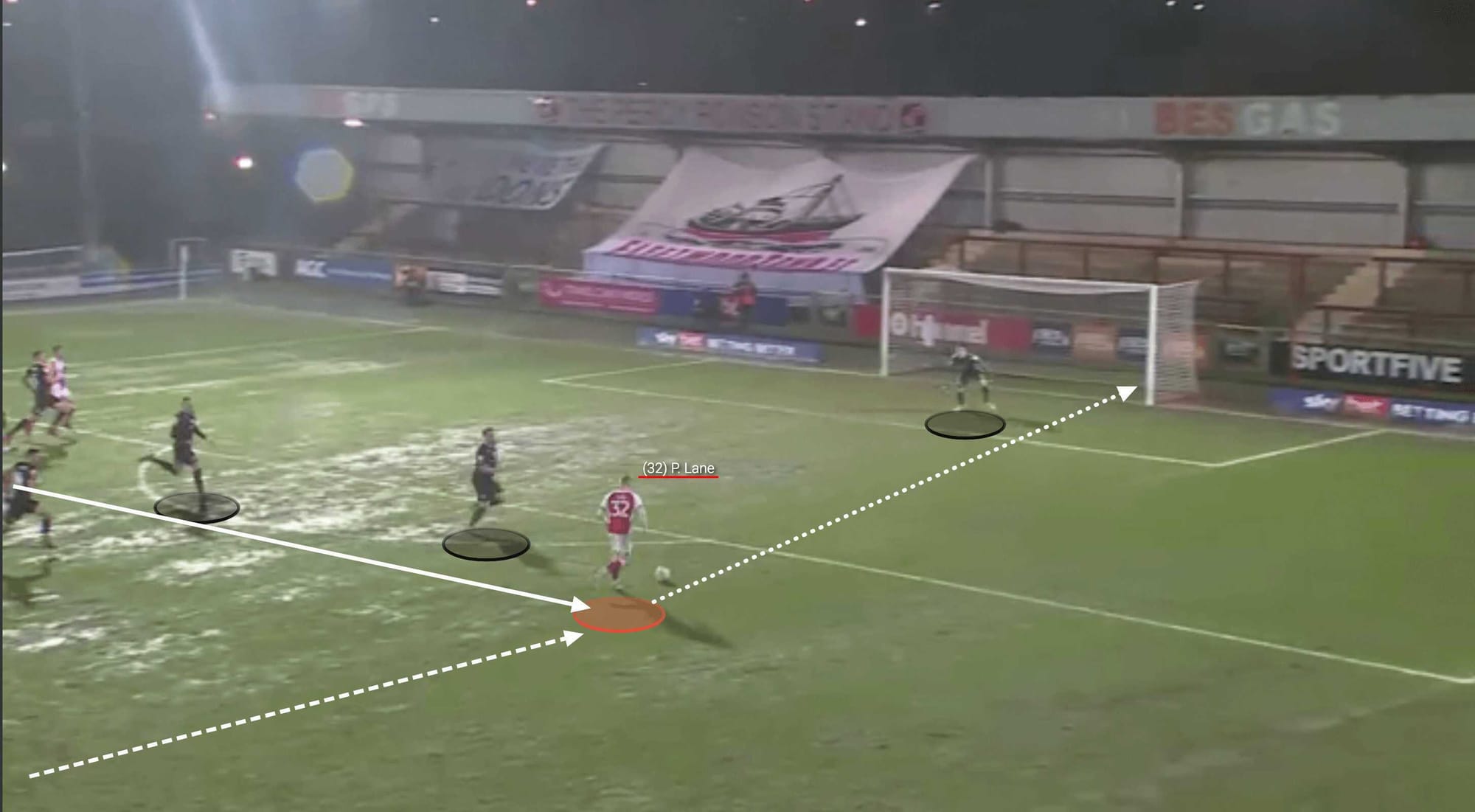
On this occasion, the shooting opportunity for Lane is created through a long run in support of the attack as the game is becoming stretched on an awful pitch. Lane is often the midfield player for Fleetwood who makes long, delayed runs to support the attack. He has also shown over the course of the season that he has a willingness to move high and get beyond the strikers in order to stretch the pitch out.
As the ball is played into the striker, it is the movement of Lane that unlocks the defence. He moves from a deeper position to attack and occupy space on the edge of the area. Crucially his run is to the outside of the opposition’s defensive structure, this means that when he receives the lateral pass, he has the time to take a touch before firing low and hard past the goalkeeper on his weaker left foot.
Occupying pockets of space
When you have a player like Lane who tends to operate, when playing as a central midfielder, as a free ‘8’ or even as a ’10’ the key thing is that he is able to find and occupy pockets of space inside the opposition defensive structure. While the likes of Bernardo Silva and Kevin de Bruyne are able to do this at will for Manchester City they do so in a highly structured and pre-planned attacking system. For Lane, at Fleetwood, the occupation of these pockets of space is looser and based on the individual player’s ability to read the game and identify where these spaces area.
Lane consistently looks to drop into these areas in order to receive the ball. His positioning in the half-spaces, in particular, allows him to receive the ball in space but it also gives his teammates, when they are in possession of the ball, the ability to get the ball into areas from which they can attack and threaten the opposition goal.
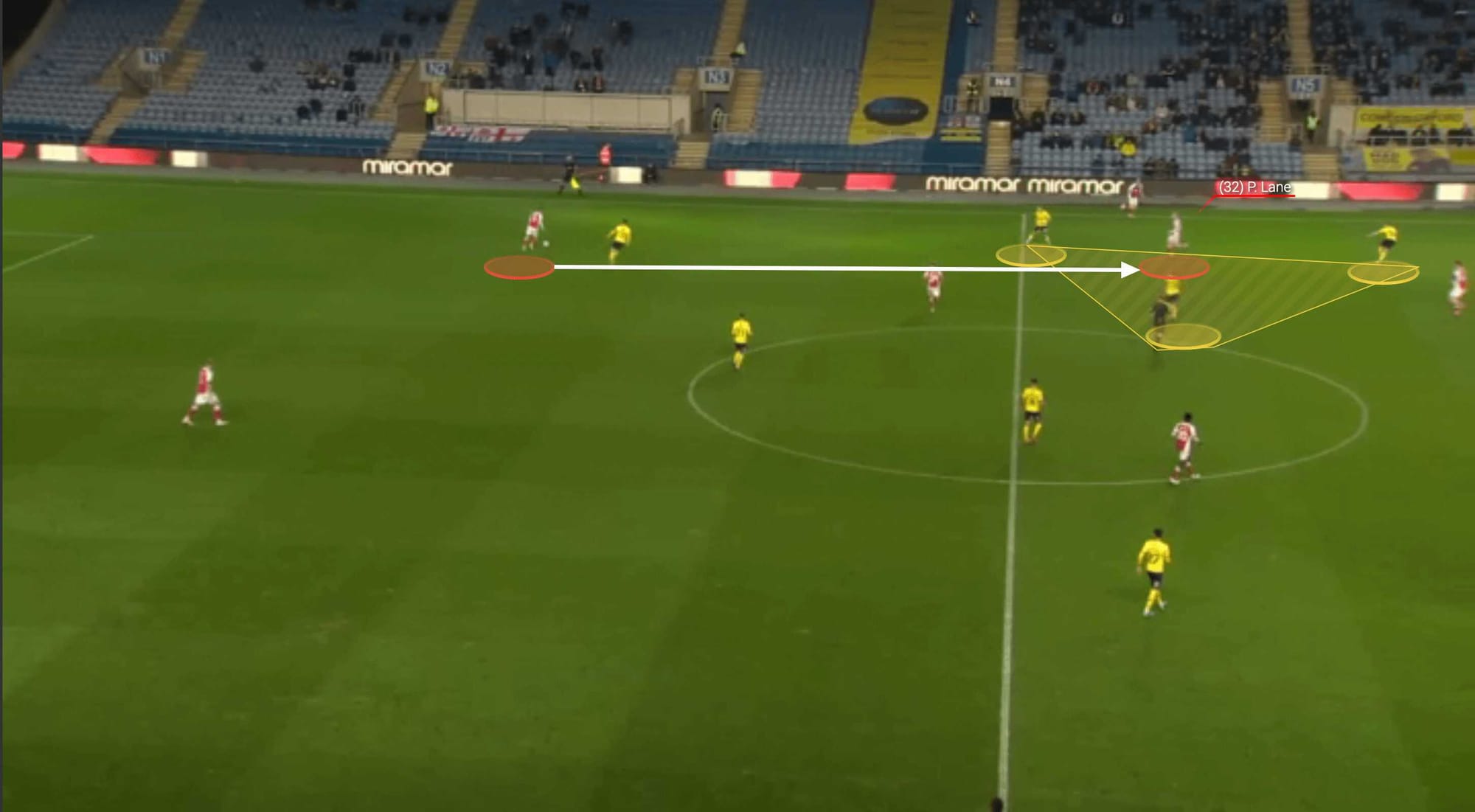
We can see an example of this here with the central defender for Fleetwood in possession of the ball. The player in possession of the ball is coming under pressure and there are no immediate clear passing options open ahead of the ball. Lane has dropped into a pocket of space behind the midfield block of the opposition. Here, the ball is fired at some force into that area in order to allow the midfielder to take possession of the ball on the turn.
While passes of these types need a player like Lane to be comfortable finding and occupying these spaces, they also require certain bravery both from the passing player and the coach in order to encourage the ball to be played out like this.
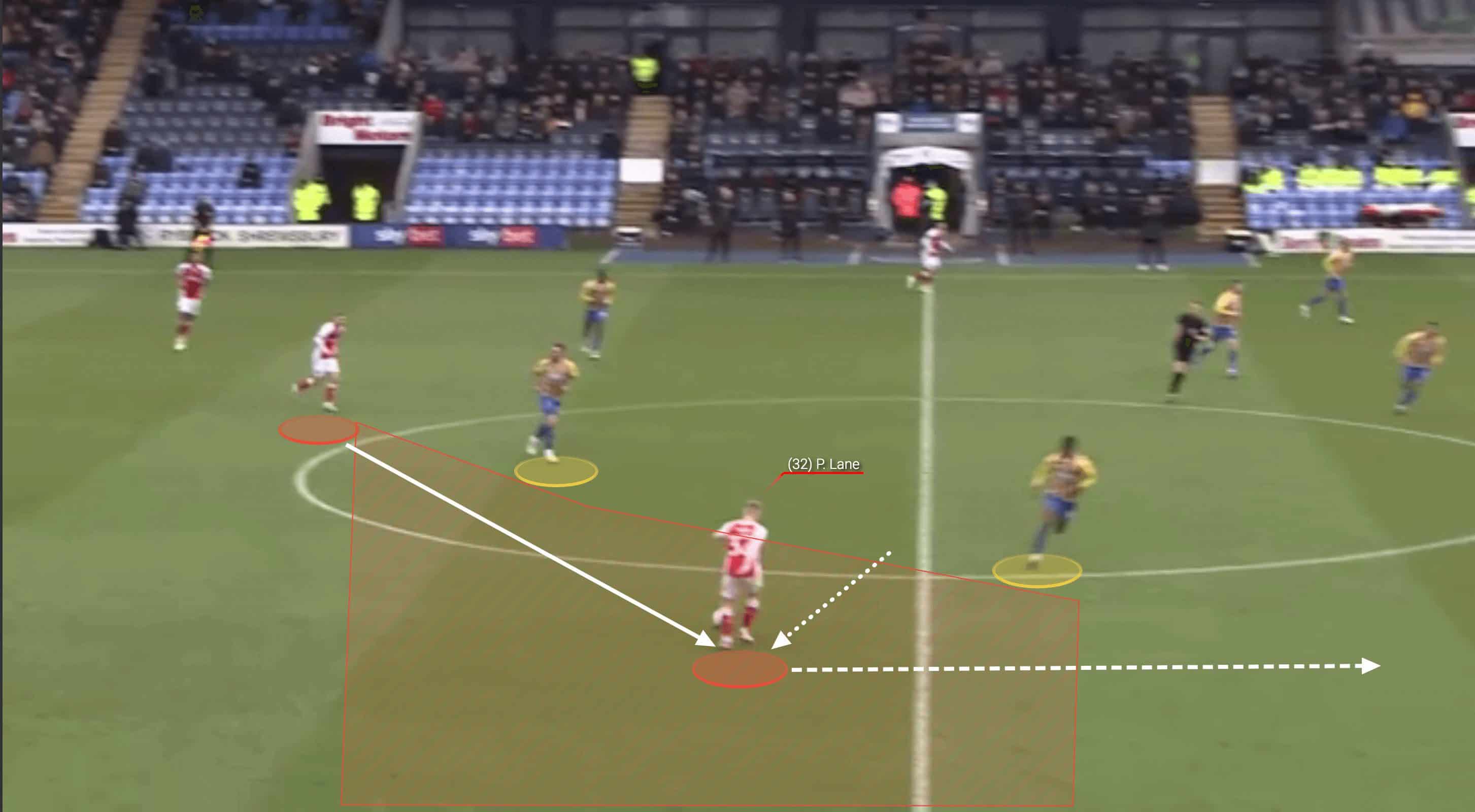
There are, of course, times in which the ball cannot be safely progressed, such as when the opposition are pressing aggressively and matching Fleetwood man on man on the first line, and in these situations, Lane also shows the game intelligence to allow him to drop off in front of the midfield line in order to take possession of the ball.
We see an example of that here as Lane drops into the right-sided half-space and receives the ball from the central defender. He is able to open out on his first touch and push the ball past the opposition midfielder before driving forward and into space.
Creativity in the final third
While we are already aware that Paddy Lane is not a volume passer that does not mean that he is not a creative passer of the ball when in and around the final third. He is a threat to shoot from range but over the course of the last season, he has also displayed that he is a threat to find the last pass that breaks the defensive line of the opposition and provides an opportunity to make runs that break the defensive line.
Lane has the ability to see the pass when moving in traffic but also to execute it without overhitting the ball.
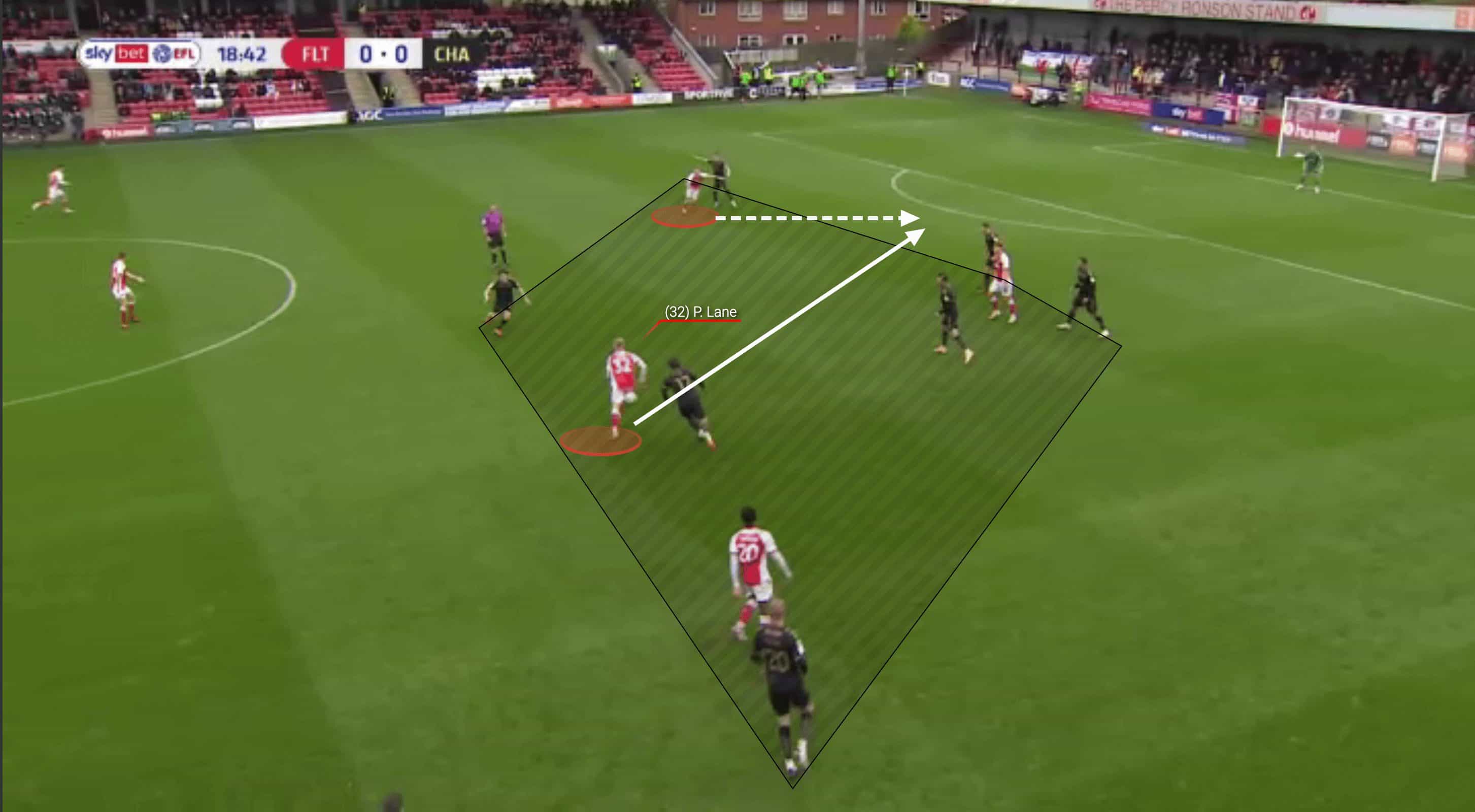
We see an example of this in action in this image as Lane has received the ball in the near side half-space. He spins inside and again has the burst to leave a defender struggling to close the gap, and moves centrally. As you can see there is another defensive player moving to close him down and put the ball under pressure. Lane has the presence of mind to keep his head high, despite the pressure, and to see the teammate on the far side who is about to make a diagonal run to break the last line and attack the space.
The fact that Lane is able to execute passes off of either foot allows him to then play the ball through and into space behind the defensive line.
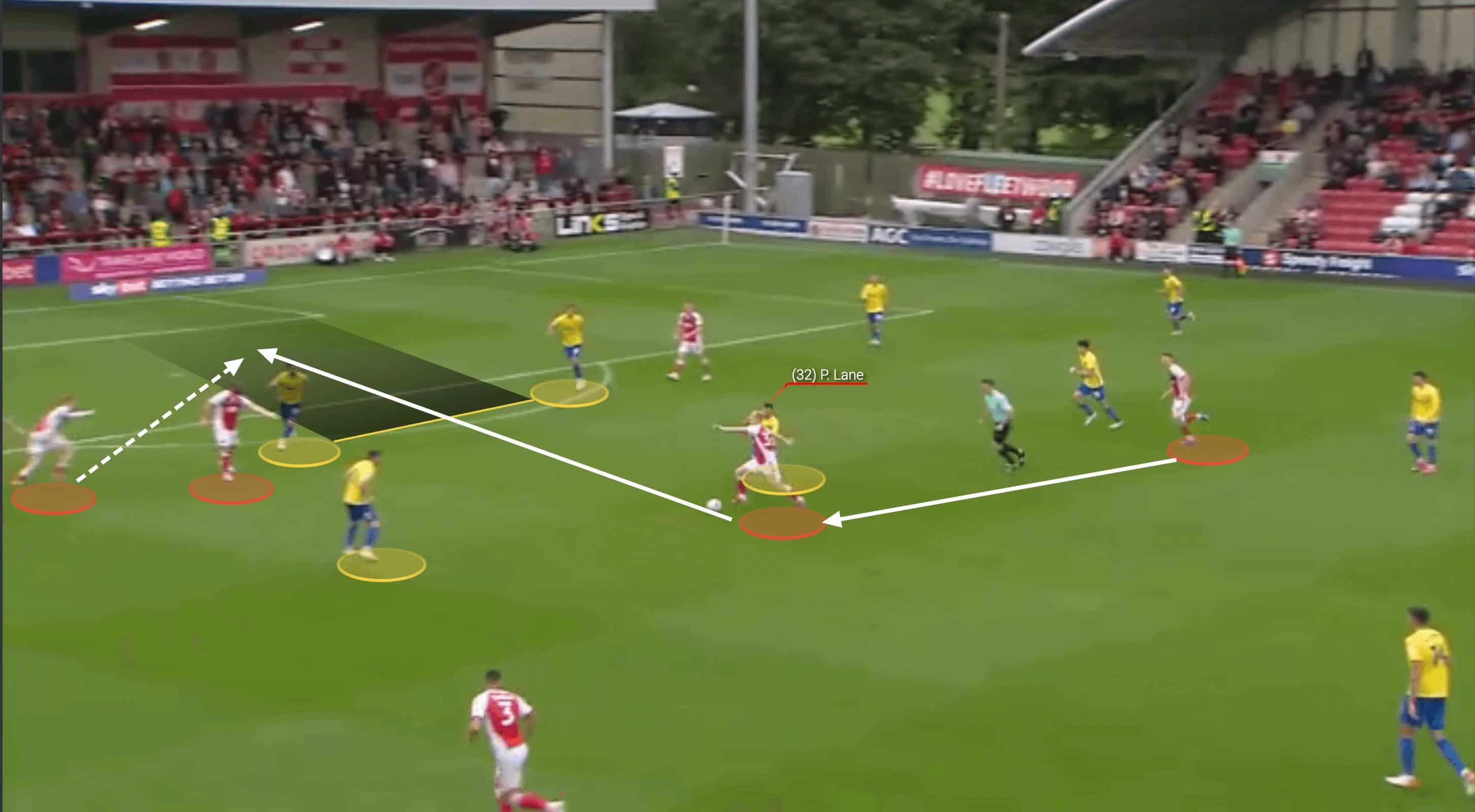
A similar situation here as Lane is, again, moving in possession of the ball across the width of the pitch. As he does so he is again put under pressure, with a player trying to shadow his run and put pressure on the ball.
Again, however, the key is that Lane keeps his head up as he is moving in possession and as such he sees a teammate moving off of the corner of the opposition area. He has the technique to play a through ball that splits the central defenders and releases the run of the player into the area.
Conclusion
Paddy Lane is a young player with a bright future in the game. He has already faced adversity and struggle in his career but he has shown that he has the determination and the commitment to bounce back and to get himself into a position from which he can make a real impact.
He was one of the best players in League One last season, despite having to come in and adapt to a better standard of opposition and he already looks as though he is ready to make the next step in his career. While links to the likes of West Ham United are no doubt flattering for the youngster, a move to the Championship as a stepping stone might make more sense, to begin with.






Comments